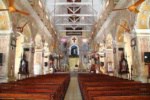14 Popular Bridges in India
Picture people back in the time, walking through a forest clearing that opens into a river and finding a dead tree stretching from one side of the river to the other. And there comes the first bridge. Ever since this discovery, pushed the limits of engineering and design and improved on the dead tree to make it possible to put a bridge anywhere – spanning rivers, traversing mountains, and connecting countries. Clearly then, we have lived without bridges.
Bridges are no ordinary structures. They are beautiful roads that lead men towards success, happiness, and prosperity. Bridges are an important factor in assessing the infrastructure capacity of any place. They are built for connecting places that are divided by water, valleys, and other obstacles. These are important structures that open business avenues, reduce travel time, expedite the regional economy and boost the job prospects of people near it. Here’s the list of the popular bridges in India. They’re also epitomes of state-of-the-art engineering technology and foresight. Some of these bridges are among the longest and highest bridges in the world. Some bridges are made of steel, while concrete and other metals are used in some. These bridges make life easier for people as some have been built in places where it seemed impossible. Salute to our civil engineers for building such magnificent structures.
Dhola Sadiya Bridge
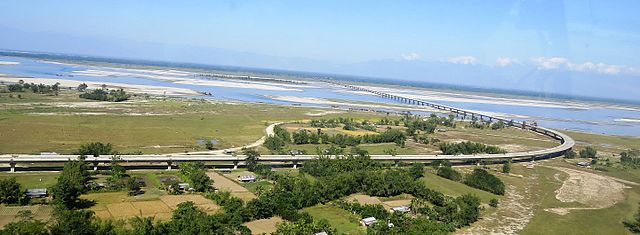
The Dhola–Sadiya Bridge, also referred to as the Bhupen Hazarika Setu, is a beam bridge in India, connecting the northeast states of Assam and Arunachal Pradesh.[1] The bridge spans the Lohit River, a major tributary of the Brahmaputra River, from the village of Dhola (Tinsukia District) in the south to Sadiya to the north.[2] The bridge is the first permanent road connection between the northern Assam and eastern Arunachal Pradesh.[3] At 9.15 kilometres (5.69 mi) in length, it is the longest bridge in India over water.[4][5] However, the 9.76 kilometres (6.06 mi) Kacchi Dargah–Bidupur Bridge under construction in the Indian state of Bihar, is expected to become the longest bridge in India upon its estimated completion in November 2021.
Read More About Dhola Sadiya Bridge / Source
Bandra Worli Sea Link
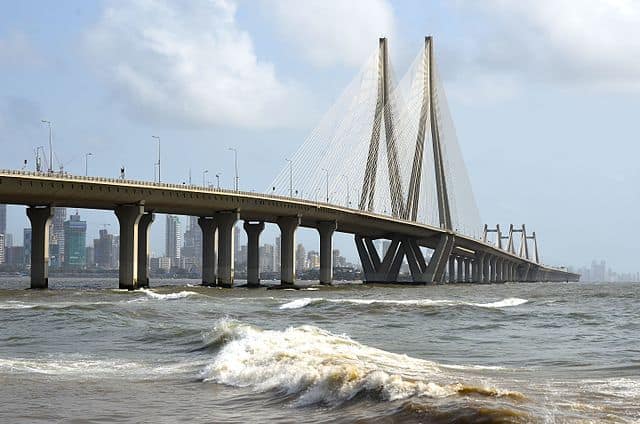
The Bandra–Worli Sea Link (officially known as Rajiv Gandhi Sea Link) is a bridge that links Bandra in the Western Suburbs of Mumbai with Worli in South Mumbai. It is a cable-stayed bridge with pre-stressed concrete-steel viaducts on either side. It is a part of the proposed Western Freeway that will link the Western Suburbs to Nariman Point in Mumbai’s main business district.
The 1M bridge was commissioned by the Maharashtra State Road Development Corporation (MSRDC), and built by the Hindustan Construction Company. The first four of the eight lanes of the bridge were opened to the public on 30 June 2009. All eight lanes were opened on 24 March 2010.
The sea-link reduces travel time between Bandra and Worli during peak hours from 20–30 minutes to 10 minutes. As of October 2009, BWSL had an average daily traffic of around 37,500 vehicles.
Read More About Bandra Worli Sea Link / Source
Dibang River Bridge
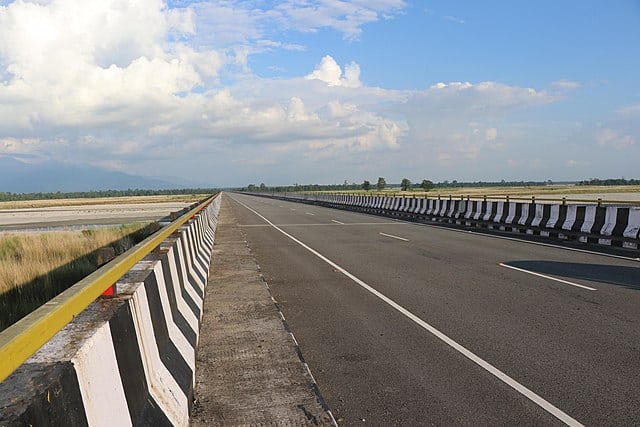
The Dibang River Bridge, completed in 2018 as part of NH13 Trans-Arunachal Highway, is a 6.2 km long road bridge across Dibang River which connects Bomjir and Malek villages and provides all-weather connectivity between Dambuk and Roing in eastern part of Arunachal Pradesh state of India. This strategically important bridge helps Indian military combat anti-national activities and Chinese military threat in the easter sector of Line of Actual Control border areas. It is known as “Talon” in Idu Mishmi language and as “Sikang” in area inhabited by Padam people. it is sometimes also referred to as “Sisseri River bridge”.
Read More About Dibang River Bridge / Source
Mahatma Gandhi Setu
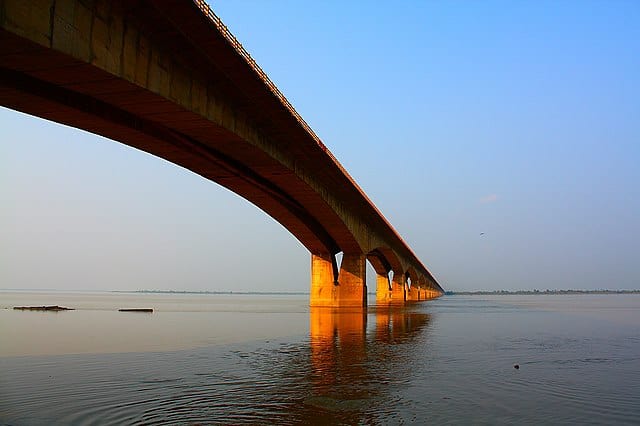
Mahatma Gandhi Setu (also called Gandhi Setu or Ganga Setu) is a bridge over the river Ganges in Bihar, India, connecting Patna in the south to Hajipur in the north. Its length is 5,750 metres (18,860 ft) and it is the third-longest river bridge in India. It was inaugurated in May 1982 in a ceremony in Hajipur by the then prime minister, Indira Gandhi. From 1982 to 2017, Mahatma Gandhi Setu remained as the longest bridge in India.
Read More About Mahatma Gandhi Setu / Source
Bogibeel Bridge

Bogibeel bridge is a combined road and rail bridge over the Brahmaputra River in the northeastern Indian state of Assam between Dhemaji district and Dibrugarh district, which was started in the year 2002 and took a total of 200 months to complete, Bogibeel river bridge is the longest rail-cum-road bridge in India, measuring 4.94 kilometres over the Brahmaputra river. As it is situated in an earthquake-prone area it is India’s first bridge to have fully welded steel-concrete support beams that can withstand earthquakes of magnitudes up to 7 on the Richter Scale. It is Asia’s 2nd longest rail-cum-road bridge and has a serviceable period of around 120 years. It is the 5th longest bridge in India after Bhupen Hazarika Setu, Dibang River Bridge, Mahatma Gandhi Setu and Bandra-Worli Sea Link. The bridge was constructed by a consortium of construction companies headed by Hindustan Construction Company. The bridge has a double rail line on the lower deck and a 3 lane road on the upper deck.
It was inaugurated by prime minister Narendra Modi on 25 December 2018 on the occasion of Good Governance Day.
Read More About Bogibeel Bridge / Source
Vikramshila Setu

Vikramshila Setu is a bridge across the Ganges, near Bhagalpur in the Indian state of Bihar named after the ancient Mahavihara of Vikramashila which was established by King Dharmapala (783 to 820 A.D.) .
Vikramshila Setu is 5th longest bridge over water in India. The 4.7 km long two lane bridge serves as a link between NH 33 and NH 31 running on the opposite sides of the Ganges. It runs from Barari Ghat on the Bhagalpur side on the south bank of the Ganges to Naugachia on the north bank. It also connects Bhagalpur to Purnia and Katihar. This has reduced considerably the road travel between Bhagalpur and places across the Ganges.
However, there is intense traffic congestion on the bridge due to increased traffic and there is now a demand to construct another bridge parallel to it. On 21 September 2020 Prime Minister Mr Narendra Modi laid the foundation stone of another 4 lane road bridge of 4.445 km length over Ganga river parallel to Vikramshila Setu at cost of Rs. 1110.23 crore.
In June 2018, another 24 km-long Vikramshila – Kataria rail-cum-road bridge between Vikramshila railway station (near Pirpainty south of Ganga) and Kataria railway station (near Naugachia railway station) north of the Ganga, with an expenditure of Rs 4,379.01 crore was approved.
Read More About Vikramshila Setu / Source
Digha–Sonpur Bridge
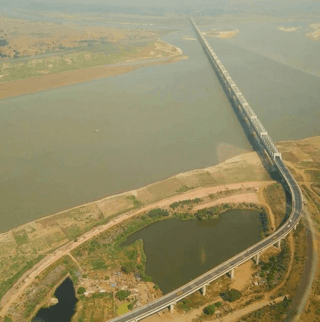
The Digha–Sonpur bridge is a rail-cum-road bridge across river Ganga, connecting Digha Ghat in Patna and Pahleja Ghat in Sonpur, Saran district in the Indian state of Bihar. It is named after Indian independence activist Jayaprakash Narayan (J.P.). The rail-cum-road bridge provides easy roadway and railway link between northern and southern parts of Bihar. It is a steel truss bridge. Regular scheduled passenger rail service was inaugurated on this route on 3 February 2016. This bridge of 4,556 metres (14,948 ft) length is the second longest rail-cum-road bridge in India, after Bogibeel Bridge in Assam.This is second railway bridge in Bihar after Rajendra Setu that connects North Bihar to South Bihar. Indian railways has constructed two railway stations on either sides of the bridge – Patliputra Junction railway station (PPTA) and Bharpura Pahleja Ghat Junction railway station (PHLG). The distance between the Digha-Sonpur bridge and Digha Bridge Halt is around 2 km.
Read More About Digha–Sonpur Bridge / Source
Vembanad Rail Bridge

Vembanad Rail Bridge is a rail connecting Edappally and Vallarpadam in Kochi, Kerala. With a total length of 4,620 metres, it is the second longest railway bridge in India. The line was dedicated solely for freight, but is now defunct.
Read More About Vembanad Rail Bridge / Source
Arrah–Chhapra Bridge
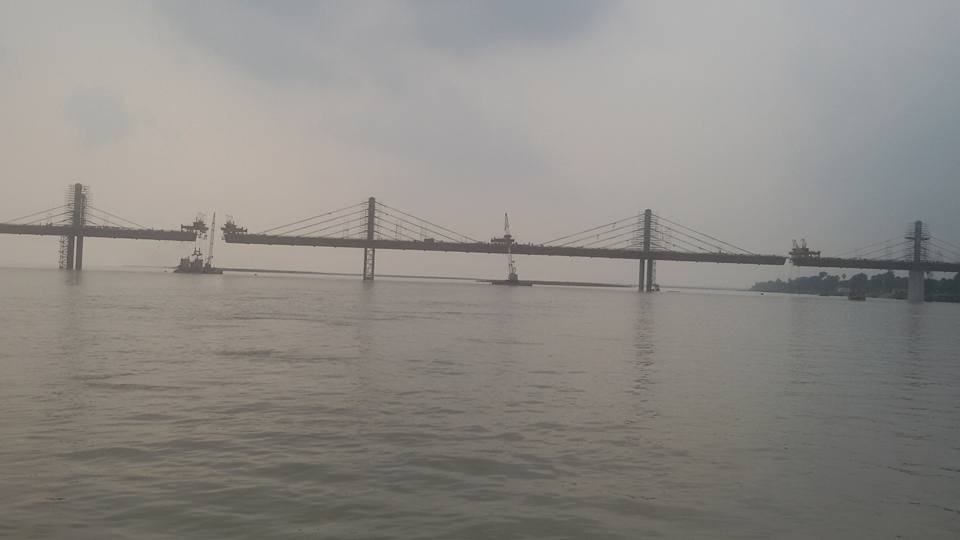
Arrah–Chhapra Bridge or Veer Kunwar Singh Setu is the longest multi-span extradosed bridge in the world with a main bridge length of 1,920 m (6,300 ft). The bridge crosses over the Ganges River in India, connecting Arrah in Bhojpur district to Chhapra in Saran district of Bihar state.
The bridge provides a roadway link between the northern and southern parts of Bihar.
The bridge opened for public use on 11 June 2017.As of December 2020, it is the 9th longest bridge above water in India. The second longest extradosed bridge is Kiso-gawa bridge in Japan which is 275 m long.
Read More About Arrah–Chhapra Bridge / Source
Godavari Fourth Bridge
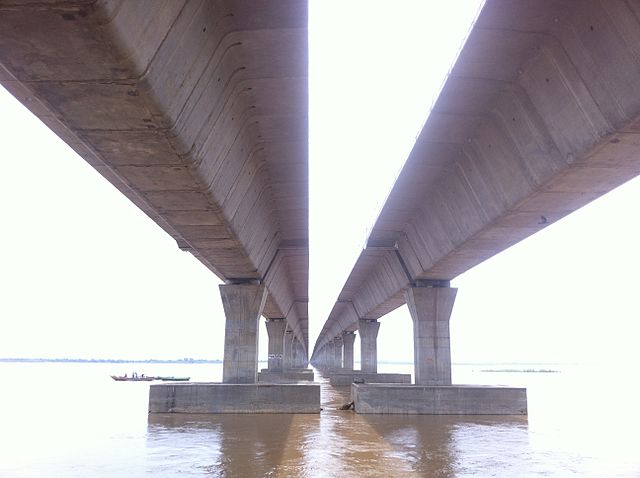
The Godavari Fourth Bridge or Kovvur–Rajahmundry 4th Bridge is built across Godavari River in Rajahmundry, India. This dual bridge connects Kovvur to Diwancheruvu Junction in Rajamahendravaram in via Katheru, Konthamuru, Palacherla areas in Rajamahendravaram City. This bridge was constructed, aimed to reduce road distance between Kolkata and Chennai by at least 150 kilometres (93 mi).
Read More About Godavari Fourth Bridge / Source
Munger Ganga Bridge
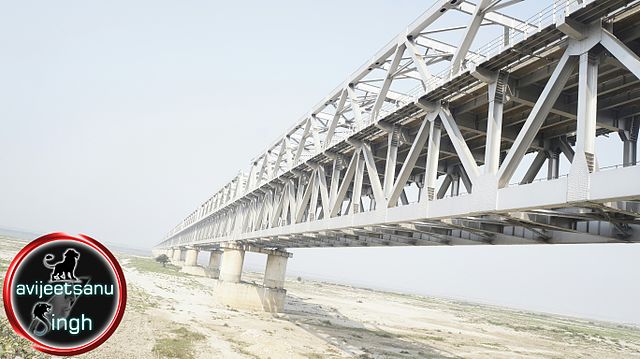
Srikrishna Setu Munger Ganga Bridge, is a rail-cum-road bridge across the Ganges, at Munger in the Indian state of Bihar. The bridge connects Munger District Munger-Jamalpur twin cities to various districts of North Bihar. Srikrishna Setu Munger Ganga Bridge is the third rail-cum-road bridge over Ganga in Bihar.
The 3.750-kilometre-long (2.330 mi) bridge costing Rs. 9,300 million is located 60 kilometres (37 mi) downstream of the Rajendra Setu near Mokama and 63 kilometres (39 mi) upstream of the Vikramshila Setu at Bhagalpur. The bridge will form a link between NH 33 on the southern side of the Ganges and NH 31 on the northern side of the Ganges. Shrikrishna Setu connects Jamalpur Junction and Ratanpur railway station on the Sahibganj Loop line of Eastern Railway through a new junction namely Sabdalpur Junction on north end of bridge to Sahebpur Kamal Junction and Khagaria Junction on the Barauni-Katihar section of East Central Railway. The Bridge connects districts of Begusarai and Khagaria to the Divisional headquarters Munger city.
Read More About Munger Ganga Bridge / Source
Howrah Bridge

Howrah Bridge is a Balanced Cantilever Bridge over the Hooghly River in West Bengal, India. Commissioned in 1943, the bridge was originally named the New Howrah Bridge, because it replaced a pontoon bridge at the same location linking the two cities of Howrah and Kolkata (Calcutta). On 14 June 1965 it was renamed Rabindra Setu after the great Bengali poet Rabindranath Tagore, who was the first Indian and Asian Nobel laureate. It is still popularly known as the Howrah Bridge.
The bridge is one of four on the Hooghly River and is a famous symbol of Kolkata and West Bengal. The other bridges are the Vidyasagar Setu (popularly called the Second Hooghly Bridge), the Vivekananda Setu and the newly built Nivedita Setu. It weathers the storms of the Bay of Bengal region, carrying a daily traffic of approximately 100,000 vehicles and possibly more than 150,000 pedestrians, easily making it the busiest cantilever bridge in the world. The third-longest cantilever bridge at the time of its construction, the Howrah Bridge is currently the sixth-longest bridge of its type in the world.
Read More About Howrah Bridge / Source
Ram Setu (Adam's Bridge)

Adam’s Bridge, also known as Rama’s Bridge or Rama Setu, is a chain of limestone shoals, between Pamban Island, also known as Rameswaram Island, off the south-eastern coast of Tamil Nadu, India, and Mannar Island, off the north-western coast of Sri Lanka. Geological evidence suggests that this bridge is a former land connection between India and Sri Lanka.
The bridge is 48 km (30 mi) long and separates the Gulf of Mannar (south-west) from the Palk Strait (northeast). Some of the regions are dry, and the sea in the area rarely exceeds 1 metre (3 ft) in depth, thus hindering navigation. It was reportedly passable on foot until the 15th century when storms deepened the channel. Rameshwaram temple records say that Adam’s Bridge was entirely above sea level until it broke in a cyclone in 1480.
Read More About Ram Setu (Adam's Bridge) / Source
Chenab Bridge
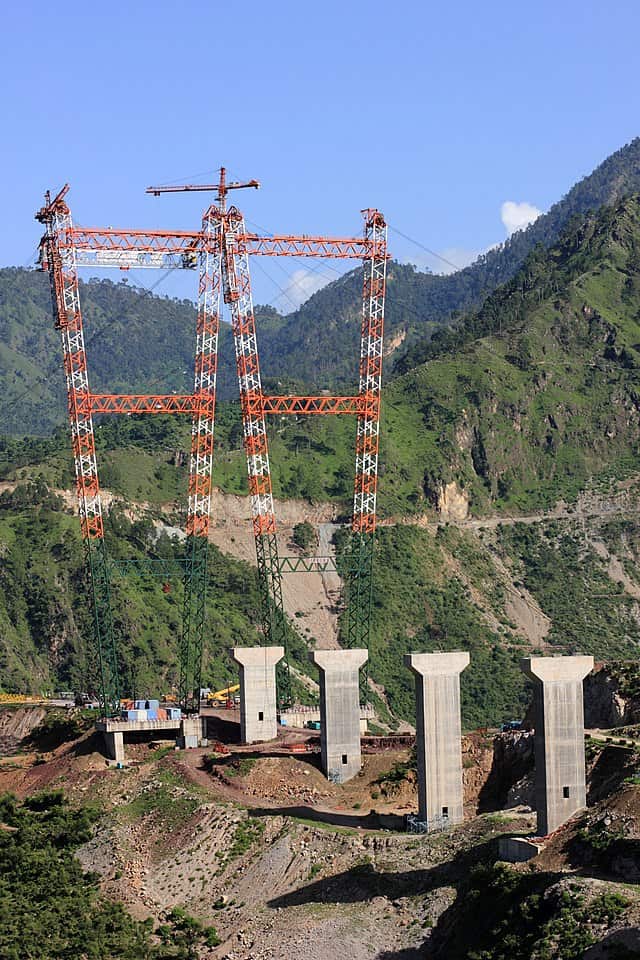
The Chenab Bridge is an Indian railway steel and concrete arch bridge under construction between Bakkal and Kauri in the Reasi district of Jammu and Kashmir in India. When completed, the bridge will span the Chenab River at a height of 359 m (1,178 ft) above the river, making it the world’s highest rail bridge.
Read More About Chenab Bridge / Source

